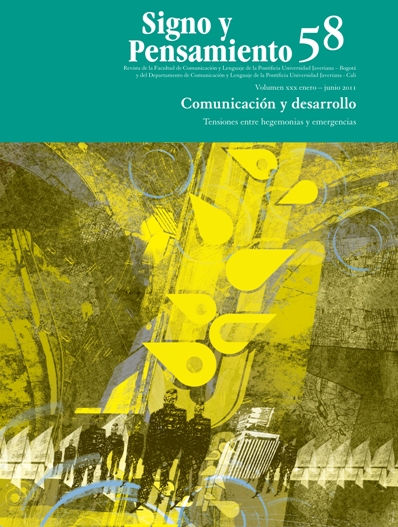Resumen
El artículo revisa los conceptos clave de la comunicación para el desarrollo y el cambio social desde sus orígenes, en los años posteriores a la Segunda Guerra Mundial, hasta nuestros días. Dos corrientes principales se distinguen durante las cinco décadas pasadas: por una parte, una comunicación inspirada en las teorías de la modernización y en técnicas derivadas de las estrategias de información utilizadas por el gobierno de Estados Unidos durante la Segunda Guerra Mundial y por la industria norteamericana para publicitar sus productos comerciales; y por otra, una comunicación nacida de las luchas sociales anticoloniales y antidictatoriales del Tercer Mundo, que tienen su referente académico en las teorías de la dependencia.
Downing, J. (1984), Radical Media: The Political Experience of Alternative Communication, Boston, South End Press.
Fraser, C. y Restrepo, S. (1998), Communicating for Development: Human Change for Survival, Londres, Nueva York, Taurus. Freire, P. (1991), ¿Extensión o comunicación? La concientización en el medio rural, México, Siglo xxi [primera edición: 1971, Santiago de Chile, incira).
Gumucio-Dagron, A. (1991), “The Overmarketing of Social-Marketing”, en Development Communication Report (dcr), No. 73, Washington, Academy for Educational Development (aed).
— (2001), Haciendo olas: historias de comunicación participativa para el cambio social, New York, The Rockefeller Foundation.
— (2003), “Take Five: A Handful of Essentials for ICTs in Development”, en: Girard, B. (ed.), The One to Watch, Rome, fao.
— (2010). “Cuando el doctor no sabe: comentarios críticos sobre promoción de la salud, comunicación y participación”, en Estudios sobre las Culturas Contemporáneas, Revista de Investigación y Análisis (pág. 67-93), Época ii, Volumen xvi, Número 31, Verano 2010. Colima: Universidad de Colima.
— y Lupe Cajías, L. (eds.) (1989), Las radios mineras de Bolivia, La Paz, cimca-Unesco. Hornik, R. (1988), Development Communication: Information, Agriculture and Nutrition in the Third World, New York, Longman.
Lerner, D. (1958), The Passing of Traditional Society: Modernizing the Middle East, New York, Free Press.
MacBride, S. (ed.), (1980). Many Voices, One World. Communication and society today and tomorrow, Paris: Unesco.
Moemeka, A. (1994), Communicating for Development: A New Pan-Disciplinary Perspective, Albany, Nueva York, State University of New York Press.
Rogers, E. M. (1962), The Diffusion of Innovations, New York, Free Press of Glencoe.
— (1976), “Communication and Development: The Passing of the Dominant Paradigm”, en: Rogers, E. (ed.), Communication and Development: Critical Perspectives, London: Sage, pp. 121-148.
Servaes, J. (1989), One World, Multiple Cultures: A New Paradigm on Communication for Development, Leuven, Acco.
Tufte, T. (2001). “Entertainment-Education and Participation-Assessing the Communication Strategy of Soul City”, en: Journal of International Communication, vol. 7, núm. 2, pp. 25-51.
Esta revista científica se encuentra registrada bajo la licencia Creative Commons Reconocimiento 4.0 Internacional. Por lo tanto, esta obra se puede reproducir, distribuir y comunicar públicamente en formato digital, siempre que se reconozca el nombre de los autores y a la Pontificia Universidad Javeriana. Se permite citar, adaptar, transformar, autoarchivar, republicar y crear a partir del material, para cualquier finalidad (incluso comercial), siempre que se reconozca adecuadamente la autoría, se proporcione un enlace a la obra original y se indique si se han realizado cambios. La Pontificia Universidad Javeriana no retiene los derechos sobre las obras publicadas y los contenidos son responsabilidad exclusiva de los autores, quienes conservan sus derechos morales, intelectuales, de privacidad y publicidad.
El aval sobre la intervención de la obra (revisión, corrección de estilo, traducción, diagramación) y su posterior divulgación se otorga mediante una licencia de uso y no a través de una cesión de derechos, lo que representa que la revista y la Pontificia Universidad Javeriana se eximen de cualquier responsabilidad que se pueda derivar de una mala práctica ética por parte de los autores. En consecuencia de la protección brindada por la licencia de uso, la revista no se encuentra en la obligación de publicar retractaciones o modificar la información ya publicada, a no ser que la errata surja del proceso de gestión editorial. La publicación de contenidos en esta revista no representa regalías para los contribuyentes.


